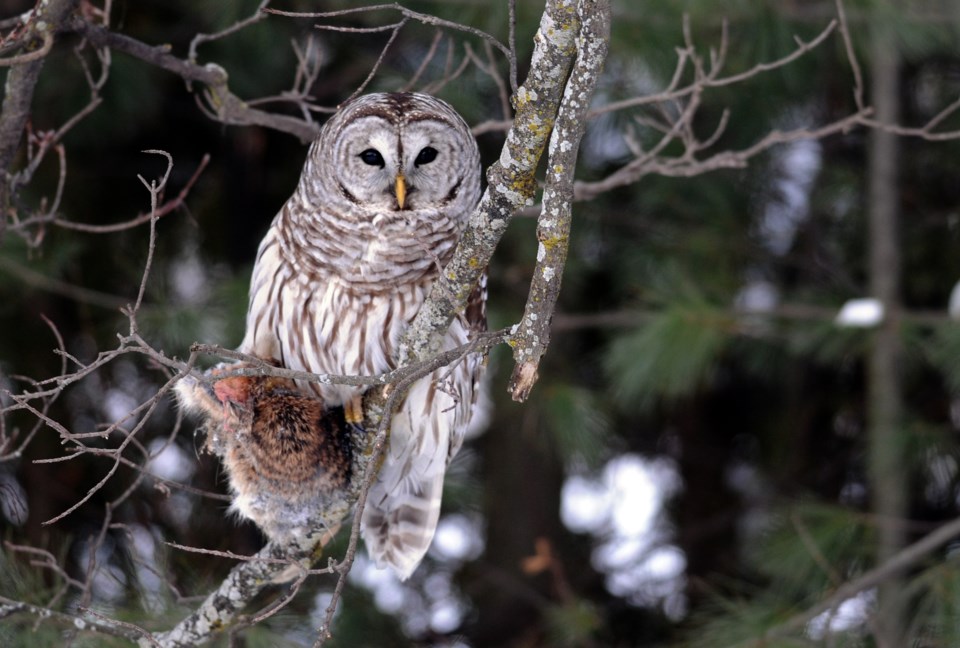I tend to think that we all like to see wild owls, whether you are a dedicated birdwatcher or just someone who has stumbled upon one. Those big, bright, forward- facing eyes certainly sets them apart from any other bird.
In mid-winter you have a chance (not a good one, but a chance nonetheless) to see either a snowy owl, a great horned owl, a barred owl, or a screech owl. For three of these your chance of success at finding one is pretty slim. However, hopes of sighting a barred owl would be your better bet, whether you are in the country or in an urban setting.
Barred owls, so named for the vertical brown markings on their breast feathers, are often quite accommodating in letting you have good look at them. They hunt by just hanging around. Hanging around your bird feeder, or that pile of garden debris at the back of the yard, wherever mice, voles or cottontail rabbits may also be hanging out.
While other predatory birds, such as crows, blue jays, northern shrikes or sharp-shinned hawks are usually noticed by us because of their flight, finding a roosting barred owl takes a moment to notice that odd-looking lump in the tree that wasn’t there the last time you checked.
One of the cool things about barred owls is that they have brown eyes; all the other owls have a yellow iris. Someone once wrote that looking at a barred owl was akin to looking at an Inuit woman wearing a big fur hood ... bright eyes quietly and intently checking you out.
The 12 different calls made by barred owls are varied, although the most common one you might hear will be the classic “who, who, who cooks for you aaalll.” If you are lucky enough to be in the same forest as a pair of conversing barred owls, their ‘monkey chatter’ sounds weirdly out of place for central Ontario. Some have described this courtship call as akin to “maniacal laughter”; I’ve heard it, and that is a pretty good description.
You may have heard of Harriet Tubman (OK, by now you should have heard of her) who was not only an avid nature lover, but a key player in the operation of the Underground Railroad, that unmarked path for escaping slaves to follow to get north to Canada. Apparently Harriet used her nature lore and would signal the “all clear” by imitating the call of a barred owl!
These birds mate for life (so say those who study them) and will nest inside big hollow trees or in an abandoned hawk nest. The female incubates the eggs while the male hunts and brings food home to the nest.
That food could be anything ... meadow vole, cottontail rabbit, grey squirrel, maybe a grouse, and sometimes, just to change up the menu I guess, a frog or crayfish. Even in winter. These owls, and screech owls too, have been observed wading in shallow melt waters, looking for semi-hibernating frogs.
An ‘interesting’ behaviour is that barred owls always eat the head first, the body later. If full from the first course, they may drape the remainder of the carcass over a branch and return later for ‘seconds.’
So what eats a barred owl, you may well ask. Top of the pile predators seldom have to duck and dodge on a daily basis, but there are a few enemies of these owls. A neighbouring great horned owl might invite itself to the party, or a raccoon may crawl up to the nest to eat eggs or recently hatched owlets.
Another odd characteristic about barred owls is that after the young hatch, they hang out at the nest for up to six months. Perhaps they heed mother’s call of “who cooks for you all” and consider that an invite to keep on staying on?
Eyes open everyone, especially around the bird feeders that have voles and squirrels visiting, as you may well observe a unique species that likes to hang out in your ‘hood.



